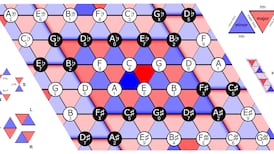MYSTERIOUS CRYSTALS could hold clues to the riddle of treating a debilitating joint disease. The tiny shards crop up in the joints of people with osteoarthritis, and a researcher at Dublin City University believes they could be a key to diagnosing and treating the condition.
There is currently no cure for osteoarthritis, a painful disease of the joints that affects around 400,000 people in Ireland, according to Dr Gillian McMahon, a researcher at the Bioanalytical Chemistry and Diagnostics Group in DCU's School of Chemical Sciences.
"It's growing at a huge rate because of the incidence of obesity, and also because we are living longer. It's sometimes called 'wear and tear disease' because it's more prevalent in the elderly, but the condition is not fully understood," she explains. At present, treating osteoarthritis often involves joint replacement, which is both invasive and expensive, notes Dr McMahon. "All they do at the moment for osteoarthritis sufferers is give them pain relief. There's no drug to treat the actual condition and that's why we got involved, we said there has to be something we can do," she says.
In particular, they are concentrating their efforts on "basic calcium phosphate"(BCP) crystals found in the fluid of many joints with osteoarthritis. It's not yet known whether the tiny, nanometre-scale crystals shear off from bones or whether they form newly within the joint fluid. Nor has it been determined whether they are a cause or effect of the condition, she notes.
But chicken-or-egg questions aside, it is established that the more severe a person's osteoarthritis, the more crystals they will have, says Dr McMahon. "They increase in their concentration with the severity of the osteoarthritis, and it's also more likely that your bones will completely wear away."
Working with rheumatologist Dr Geraldine McCarthy at the Mater Misericordiae Hospital in Dublin, the DCU group is developing a simple, on-the-spot dipstick test to determine whether BCP crystals are present in a sample of fluid taken from the joint. "A test like this would be a huge aid to doctors for diagnosis," says Dr McMahon.
Knowing more about the crystals could also pave the way for dealing with them, she adds: "If we can find the crystals, see them and handle them, then maybe we can develop a drug to target them and dissolve them and alleviate symptoms."
That's why the researchers are also using sophisticated microscopic techniques to analyse the tiny crystals at high resolution. But it's not straightforward: "The challenge is that [joint] fluid is a very complex and viscous matrix to work with, and other crystals can occur in it too, especially in patients with mixed diseases," says Dr McMahon, who receives funding from the Wellcome Trust and Enterprise Ireland.
Ultimately she hopes that working out how to extract and characterise the BCP crystals in osteoarthritis will lead to better diagnosis and treatment of the debilitating condition.











